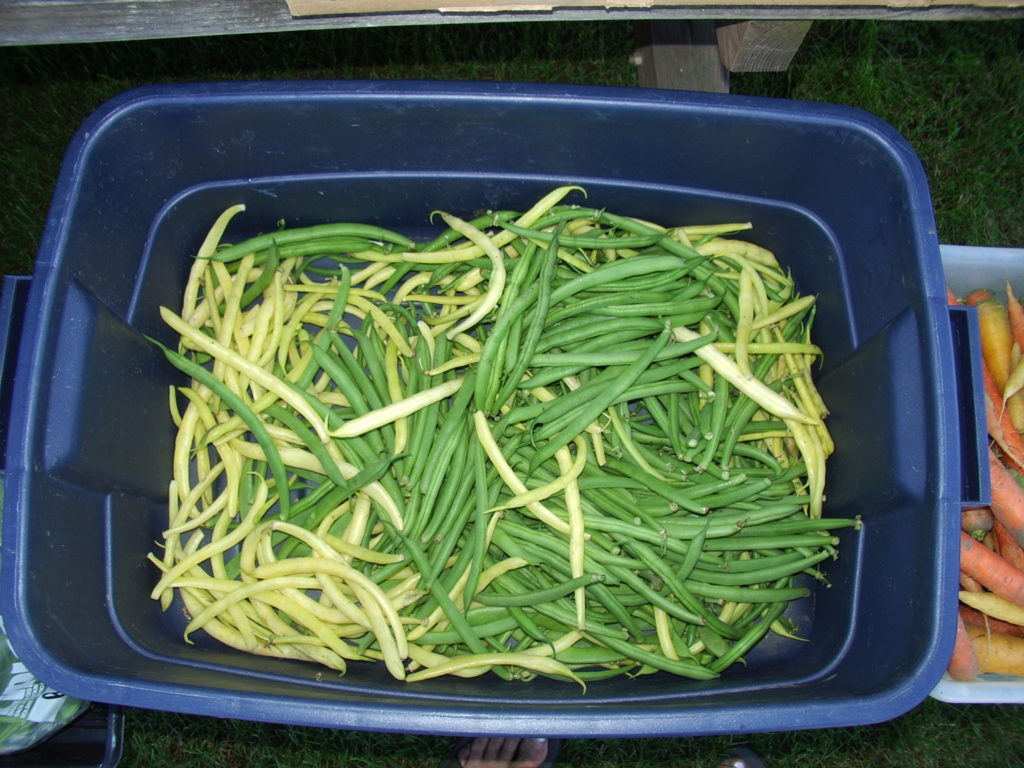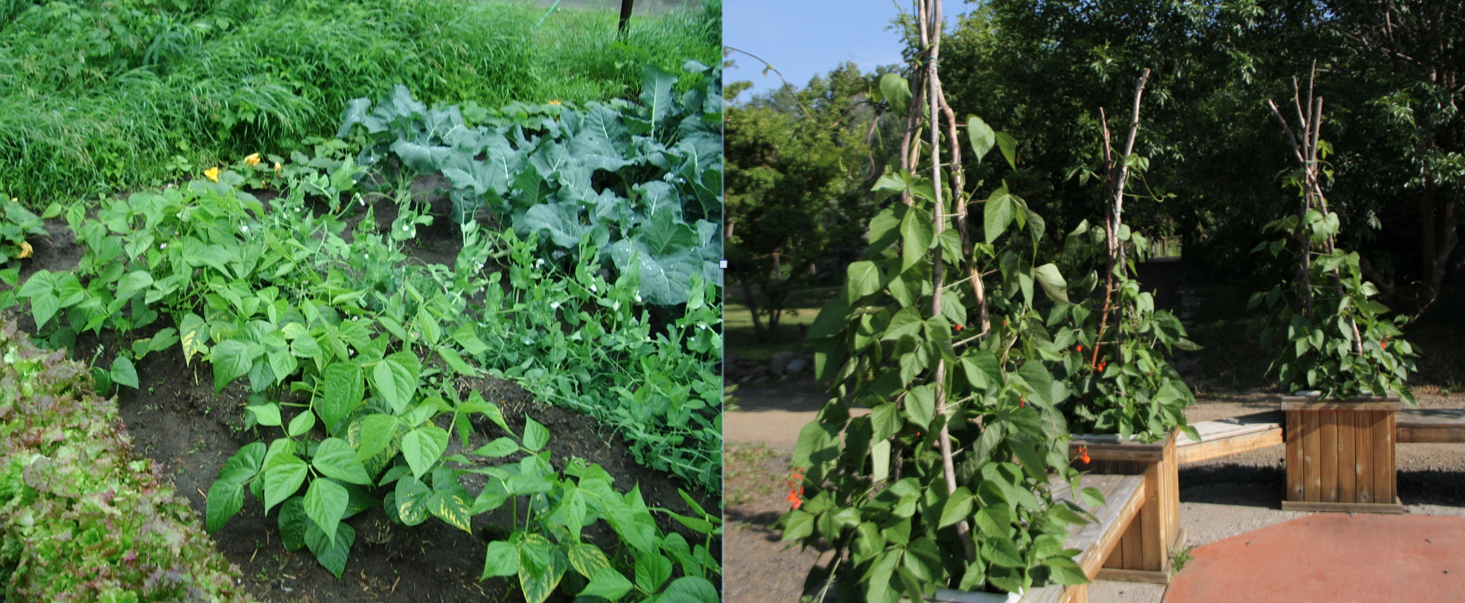The difference between a fresh green bean and a canned one is huge. But green beans (snap beans) aren’t the only kind of bean you can grow in Alaska. Runner and fava beans also do very well and you can even grow beans for the bean itself, although that requires extra patience, time, and dedication.
-

Fresh-harvested green and yellow wax beans.
Bean terminology and categories can be overlapping and confusing. For instance, a snap bean could be a bush bean or a pole bean and could also be grown just for the beans. Runner beans, a different species, can be grown with the intent of eating the entire pod, just the bean, or as an ornamental — and in the U.S. you’ll often find the seeds categorized under flowers rather than with beans in seed catalogues. Like pole beans, they are climbers and are either characterized as half-runner or runner beans. Further, fava beans are even more different and are a different genus and species than beans and runner beans.
Common beans (Phaseolus vulgaris), as you might expect, are the most commonly grown bean in Alaska. There are varieties that only get about 2 feet tall (bush beans) and ones that climb high (pole beans). Sometimes the entire pod is eaten (green or snap beans) while sometimes just the bean is eaten. There are some that produce tasty pods and beans while others are produced mainly for one or the other stage. Usually in Alaska, common beans are grown with the intent of eating the whole pod because it takes fewer days to mature — between about 50 and 60 days. Tack on at least a month or so if you want to grow them for dried beans.
-

Left, beans make a nice addition to any garden. This is a garden in Eagle, Alaska. Right, scarlet runner beans trellised with sticks and twine.
Pole beans are great if you have a small garden. They are an easy solution for maximizing your space. They are also easier to pick and less susceptible to white mold since they are kept off the ground and have more air circulation. They do take longer to mature — upwards of 60 days. There are many more varieties of bush beans than pole beans, likely because bush beans are grown commercially and harvested mechanically while pole beans are grown more in the home garden. Common beans love hot weather and are susceptible to white mold, particularly in rainy, cool summers. Bush beans can be staked to mitigate white mold problems and pole beans should always be staked to maximize productivity.
Runner beans (Phaseolus coccineus), are hardier than common beans and take upwards of 60 days to mature, and, of course, longer if you are growing them to eat the beans. Their flavor is said to be more intense than common beans and are preferred by the British and in other European countries. The pods can be a bit tough, particularly those of scarlet Runner Beans. Terry Reichardt, a committed and knowledgable Fairbanks gardener, grows scarlet runner beans for the seed and prefers to eat Stardust beans at the green bean stage because they are more tender.
Fava beans (Vicia faba), thrive in cold weather. Side note, bird vetch shares the same genus (Vicia). Fava beans are grown primarily for the beans, but sometimes the pods are roasted as well. They mature in about 75 days. The pods can be shelled and the beans frozen or dried for later consumption. Terry, a committed locavore, only grows them every other year to meet her family’s needs.
-

The last harvest of Jumbo beans in 2019 variety trials was plentiful. Photo by Glenna Gannon
Bush beans have been trialed at the Fairbanks Experiment Farm for more than 5 nonconsecutive years. Provider, Romano Gold, Contender, Rocdor and Carson top the list of varieties recommended by Extension and trialed in Fairbanks. Venture was also frequently recommended but I don’t see a good, current source for seed. In the 2018 preliminary (nonreplicated trials) in Fairbanks, Provider was the top performer, while Rocdor and Bountiful were close behind. Royal Burgundy, Royalty Purple Pod, Tendercrop, Jade II and Romano Gold were eliminated from subsequent trials because of poor performance. In replicated trials in 2019, Bountiful, Contender, Jumbo (late to mature with a large bean, which equals easy to pick) and Rocdor (a yellow bean that continued to produce late into the season) all produced similarly well and outperformed Provider, the longtime standard for Alaska gardeners.
Best bet? Personally I would choose Bountiful, Rocdor, Contender or Jumbo. I have never liked the taste of Provider much so if there are productive alternatives that do ok in our temperatures, I am happy to pass it over for other varieties.
I haven’t seen any formal trials of pole, runner or fava beans in Alaska. Terry Reichardt’s top pole bean zpick is Fortex, followed by Algarve and Kew Blue. As mentioned previously, Terry grows scarlet runner bean for the beans and Stardust for the entire pod. Broad Windsor is her favorite fava bean, followed by Negreta and Green Windsor. You can read more about bean categories and varietal characteristics on Johnny’s Selected Seeds website.
Before I plant beans, I soak them overnight to speed up germination and then sprinkle inoculant over them. This encourages them to fix some of their own nitrogen. I space them about 2 or 3 inches apart in double rows about a foot apart and trellis the pole beans. Terry recommends starting pole and runner beans indoors around April 20 and transplanting them outside. Sometimes I find that beans and peas do not transplant well and I try and direct seed whenever I can. In hot weather, Terry recommends actually spraying runner and pole beans. You can see her beautiful beans and hear more in this video.
One other bonus with beans is that many are open-pollinated and self-pollinating, so if you get them in the ground early enough to mature to the dry bean stage, it’s a cinch to save their seeds to grow next year. Instead of harvesting them as you normally would, leave some on the vine to mature fully and then start to dry. You’ll likely need a month beyond their normal maturity to do this.
Watch a corresponding about growing beans here.
For more detailed information related to growing beans, check out Minnesota’s Extension publication on the topic. For more help choosing which pea varieties to grow in Alaska, see what Extension recommends for your region (Interior or Southcentral) and which varieties performed best in trials.
Published in The Fairbanks Daily Newsminer July 19, 2020.
I live in East Sterling on the Kenai River. What bean should I
plant outdoors? I tried indoors and got good healthy plants
but few beans, so want to try outdoors in raised beds next to my
pole peas….What do you recommend ??